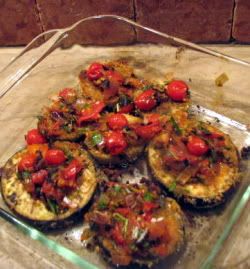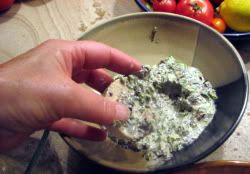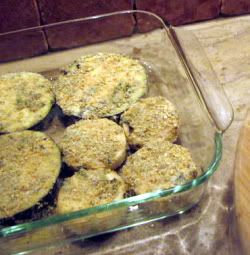One building block cooking technique, dozens of dishes
Here at EveryDay Good Eating, we like to take the mystery out of cooking. We believe everyone can make–and deserves to enjoy–deliciously healthful food, everyday. That’s why we teach basic, building block cooking techniques that can be mixed and matched to create a wide range of dishes. Breading is a perfect example. It’s an easy and inexpensive technique that can be applied to lots of different foods to create dozens of different dishes.

Why We Love Breading Who doesn’t end up with bread crusts that no one wants? Turn them into breadcrumbs and they won’t end up creating environmental havoc in a landfill.* Meanwhile, you’ll save grocery dollars and end up with a form of kitchen gold. Coat an ordinary food with breadcrumbs and suddenly it gets a welcome flavor boost and becomes something special, especially beneficial for blander foods like eggplant and zucchini. Breading also helps retain moisture for delicate foods like fish and chicken breasts that dry out easily when cooked.
Basic Breading Technique
-

Step 1: Dip the food in a "wash," here a mixture of olive oil, milk, mayonnaise and fresh herbs Dip a food in some kind of “wash,” like egg or milk
- Coat it with breadcrumbs
- Fry or bake until the breading browns and crisp.
Those are the basic elements of breading, although you’ll see dozens of variations in recipes. Sometimes, sturdier and moister foods (like chicken breasts) aren’t dipped in a wash at all, or foods are dipped in flour before the wash. The liquids used for a wash can vary from recipe to recipe. Finally, delightful variety can be achieved by including herbs, spices and other flavors with the breadcrumbs or by swapping the crumbs for different flours, cornmeal, crushed corn flakes or cracker crumbs.

Making It Healthy Breaded foods are often equated to unhealthy foods. Think chicken nuggets, fish n’ chips and eggplant parmigiana style. These foods are coated thickly with white breadcrumbs then thrown in a deep frier where they absorb ungodly amounts of bad fats. Don’t let these examples dissuade you from experimenting with this easy and delicious technique.
- Simply use a 100% whole grain breading, whether that’s breadcrumbs, flour, cracker crumbs, etc. While whole grain breadcrumbs can be difficult to find at grocery stores, they are easy (and free) to make. Check out this blog on making breadcrumbs, paying particular attention to the note on giving them a second “Fine Grind” after they are dried.
- Fry in healthful oils, like olive and safflower.
- Use moderate amounts of oil. Surprisingly, browning can be achieved nicely with just a tablespoon of oil. Be sure the oil is very warm to hot (but not smoking) before adding the food so it isn’t just absorbed by the breading. Although the second side will brown well enough in the skim of oil remaining after the first side is browned, additional oil can be added to brown the second side more thoroughly. In this case, remove the food after browning the first side, scrape out any remaining bits so they don’t burn, add another tablespoon of oil and heat before adding the food on its second side.
-

Step 3: Fry or bake. Here the eggplant is baked, but because of the oil in the wash, there was no need to spray slices with additional oil to get a nicely browned crust. Bake as an alternative to frying. The hot air circulating in an oven does a great job of browning and crisping breaded food, if the weather isn’t too hot for turning on this appliance. Best results are achieved by spraying the food with a little oil before baking.
Ready to try a breaded dish? First, find out how to make your own free, healthful, whole grains crumbs. Next, check out the post on Breaded Eggplant with Herbed Tomato Topping, which makes use of plentiful late summer and early autumn produce.
* Food waste produces methane gas which contributes far more to global warming than even carbon emissions.